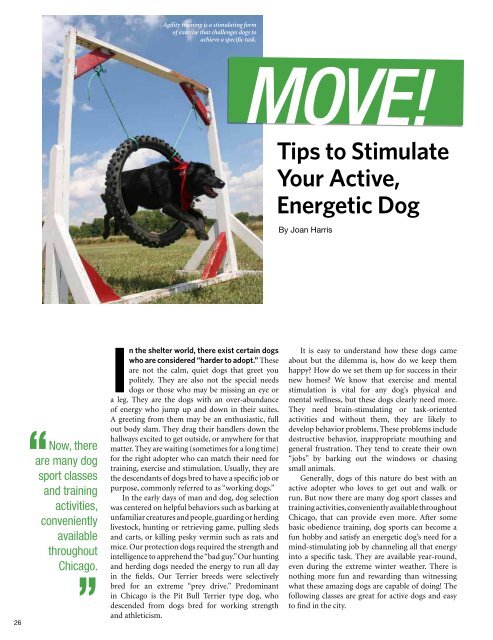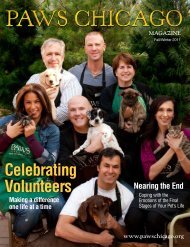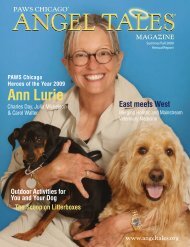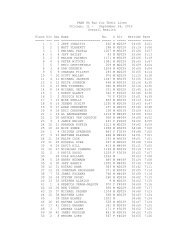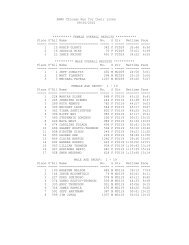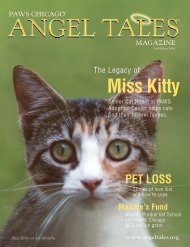Create successful ePaper yourself
Turn your PDF publications into a flip-book with our unique Google optimized e-Paper software.
Agility training is a stimulating form<br />
of exercise that challenges dogs to<br />
achieve a specific task.<br />
MOVE!<br />
Tips to Stimulate<br />
Your Active,<br />
Energetic Dog<br />
By Joan Harris<br />
CLICKER TRAINING<br />
All dogs should start with a basic training or manners class.<br />
Clicker training is a method based on behavioral psychology<br />
that relies on marking desirable behavior with a “click” and then<br />
rewarding it. The “click” tells the dog exactly when he is doing<br />
the right thing, so it can speed up communication. This method<br />
allows the dog to become an active part of the training program<br />
making it more fun and exciting.<br />
At PAWS Chicago, clicker training may have already been<br />
started for you. Clicker training is taught to our Level 2 and 3<br />
volunteers and monthly workshops are conducted to track the<br />
progress. Participating volunteers are assigned a dog to train with<br />
the goals of increasing the dog’s adoptability by teaching good<br />
manners and providing mental stimulation.<br />
Behaviors are taught by capturing (marking behaviors that<br />
the dog does naturally), targeting (teaching the dog to touch a<br />
target with his nose or paw, then moving the target to create the<br />
desired behavior), or shaping (marking increments of the final<br />
behaviors and gradually raising the criteria to reach the end goal).<br />
Once the dog can consistently offer the desired behavior, it is “put<br />
on cue” or given a name. The clicker can then be phased out and<br />
the behavior can be variably reinforced.<br />
Clicker training is a fun and exciting way to teach dogs more<br />
complicated tasks and tricks. So with a little bit of patience, your<br />
dog could learn to “take a bow,” “high five,” “roll over” or “sit<br />
pretty.” With some more work (and a motivated dog), you could<br />
teach your dog to put away his toys, close doors or even get your<br />
beer from the refrigerator!<br />
continued on page 28<br />
CLICK<br />
CLICK<br />
GOOD DOG<br />
Clicker training is a method based<br />
on behavioral psychology that relies on<br />
marking desirable behavior with<br />
a “click” and then rewarding it.<br />
26<br />
“<br />
Now, there<br />
are many dog<br />
sport classes<br />
and training<br />
activities,<br />
conveniently<br />
available<br />
throughout<br />
Chicago.<br />
“<br />
In the shelter world, there exist certain dogs<br />
who are considered “harder to adopt.” These<br />
are not the calm, quiet dogs that greet you<br />
politely. They are also not the special needs<br />
dogs or those who may be missing an eye or<br />
a leg. They are the dogs with an over-abundance<br />
of energy who jump up and down in their suites.<br />
A greeting from them may be an enthusiastic, full<br />
out body slam. They drag their handlers down the<br />
hallways excited to get outside, or anywhere for that<br />
matter. They are waiting (sometimes for a long time)<br />
for the right adopter who can match their need for<br />
training, exercise and stimulation. Usually, they are<br />
the descendants of dogs bred to have a specific job or<br />
purpose, commonly referred to as “working dogs.”<br />
In the early days of man and dog, dog selection<br />
was centered on helpful behaviors such as barking at<br />
unfamiliar creatures and people, guarding or herding<br />
livestock, hunting or retrieving game, pulling sleds<br />
and carts, or killing pesky vermin such as rats and<br />
mice. Our protection dogs required the strength and<br />
intelligence to apprehend the “bad guy.” Our hunting<br />
and herding dogs needed the energy to run all day<br />
in the fields. Our Terrier breeds were selectively<br />
bred for an extreme “prey drive.” Predominant<br />
in Chicago is the Pit Bull Terrier type dog, who<br />
descended from dogs bred for working strength<br />
and athleticism.<br />
It is easy to understand how these dogs came<br />
about but the dilemma is, how do we keep them<br />
happy? How do we set them up for success in their<br />
new homes? We know that exercise and mental<br />
stimulation is vital for any dog’s physical and<br />
mental wellness, but these dogs clearly need more.<br />
They need brain-stimulating or task-oriented<br />
activities and without them, they are likely to<br />
develop behavior problems. These problems include<br />
destructive behavior, inappropriate mouthing and<br />
general frustration. They tend to create their own<br />
“jobs” by barking out the windows or chasing<br />
small animals.<br />
Generally, dogs of this nature do best with an<br />
active adopter who loves to get out and walk or<br />
run. But now there are many dog sport classes and<br />
training activities, conveniently available throughout<br />
Chicago, that can provide even more. After some<br />
basic obedience training, dog sports can become a<br />
fun hobby and satisfy an energetic dog’s need for a<br />
mind-stimulating job by channeling all that energy<br />
into a specific task. They are available year-round,<br />
even during the extreme winter weather. There is<br />
nothing more fun and rewarding than witnessing<br />
what these amazing dogs are capable of doing! The<br />
following classes are great for active dogs and easy<br />
to find in the city.


